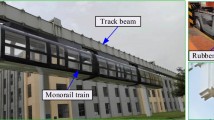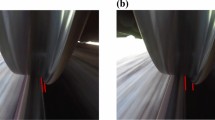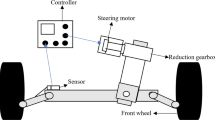Abstract
Vehicle driving stability is the basis of chassis integrated control and automatic driving. In this paper, we construct an 18 degrees of freedom (DOF) unified dynamics model of vehicle chassis. The unified dynamics model includes three subsystems: steering subsystem, brake subsystem and suspension subsystem, in which the coupling relationships among the three subsystems above are considered. Combined with phase plane analysis method, choosing the sideslip angle of vehicle center of gravity (c.g.) and yaw rate as the evaluation indexes, the influences of front wheel steering angle, road adhesion coefficient, braking mode of front and rear wheels and initial speed on vehicle driving stability are analyzed. In particular, phase plane and bifurcation analysis methods are used to study the influence of uneven road on vehicle driving stability, which has not been reported yet. The main contribution of this paper is to make a comprehensive analysis of the vehicle driving stability by the 18-DOF model above. Through the comprehensive simulation analysis of the above factors by Matlab/Simulink, we can fully grasp the driving stability law of the vehicle under different working conditions. With the above analysis method, the stability of various control systems designed for vehicle chassis can be evaluated more objectively.
Similar content being viewed by others
Abbreviations
- M :
-
mass of the vehicle, 1500 kg
- M s :
-
mass of the sprung mass, 1300 kg
- m uij :
-
mass of unsprung mass, 45 kg
- I xx :
-
roll moment of inertia of sprung mass, 530 kg·m2
- I yy :
-
pitch moment of inertia of sprung mass, 2555 kg·m2
- I zz :
-
yaw moment of inertia of the car, 3000 kg·m2
- L 1 :
-
distance of the body center of gravity to the front axle, 1.2 m
- L 2 :
-
distance of the body center of gravity to the rear axle, 1.3 m
- L :
-
distance of the front axle to the rear axle, L=L1+L2
- d :
-
track width, 1.5 m
- h :
-
distance from the sprung mass center of gravity to roll axis, 0.5 m
- K a1j :
-
front tire cornering stiffness, 25000 N/rad
- K a2j :
-
rear tire cornering stiffness, 35000 N/rad
- K s1j :
-
front suspension stiffness, 35000 N/m
- K s2j :
-
rear suspension stiffness, 38000 N/m
- C s1j :
-
front suspension damping, 1000 N·s/m
- C s2j :
-
rear suspension damping, 1100 N·s/m
- K tij :
-
tire vertical stiffness coefficient, 220000 N/m
- z s :
-
vertical displacement of gravity of sprung mass, m
- z sij :
-
vertical displacement of corner of sprung mass, m
- z uij :
-
vertical displacement of unsprung mass, m
- β :
-
sideslip angle of the car, rad
- φ :
-
angle between the absolute velocity and the Xa axis, rad
- Ψ :
-
heading angle, rad
- ϕ :
-
roll angle of sprung mass, rad
- r :
-
yawrate, rad/s
- θ :
-
pitch angle of sprung mass, rad
- V :
-
velocity of the vehicle, m/s
- v x :
-
longitudinal velocity, m/s
- v y :
-
lateral velocity, m/s
- F yij :
-
lateral force, N
- F z :
-
force on sprung mass in vertical direction, N
- u ij :
-
active suspension control force, N
- w rx :
-
roll moment disturbance, kg·m2
- w y :
-
lateral force disturbance, N
- w rz :
-
yaw moment disturbance, kg·m2
- w ij :
-
uneven road input, m
- I ϖij :
-
inertia moment of Wheel, kg·m2
- ϖ ij :
-
wheel rotation speed, r/s
- F xij :
-
braking force, N
- R ij :
-
rolling radius, m
- T bij :
-
braking torque, N·m
- i=1, 2:
-
front, rear
- j=l, r :
-
left, right
References
Ahmad, E., Iqbal, J., Arshad Khan, M., Liang, W. and Youn, I. (2020). Predictive control using active aerodynamic surfaces to improve ride quality of a vehicle. Electronics 9, 9, 1463.
Bakker, E., Nyborg, L. and Pacejka, H. B. (1987). Tyre modelling for use in vehicle dynamics studies. SAE Trans., 190–204.
Beal, C. E. and Boyd, C. (2018). Coupled lateral-longitudinal vehicle dynamics and control design with three-dimensional state portraits. Vehicle System Dynamics 57, 2, 286–313.
Bobier-Tiu, C. G., Beal, C. E., Kegelman, J. C., Hindiyeh, R. Y. and Gerdes, J. C. (2018). Vehicle control synthesis using phase portraits of planar dynamics. Vehicle System Dynamics 57, 9, 1318–1337.
Chen, K., Pei, X., Ma, G. and Guo, X. (2016). Longitudinal/lateral stability analysis of vehicle motion in the nonlinear region. Mathematical Problems in Engineering, 2016.
Dai, L. and Han, Q. (2004). Stability and Hopf bifurcation of a nonlinear model for a four-wheel-steering vehicle system. Communications in Nonlinear Science and Numerical Simulation 9, 3, 331–341.
Farroni, F., Russo, M., Russo, R., Terzo, M. and Timpone, F. (2013). A combined use of phase plane and handling diagram method to study the influence of tyre and vehicle characteristics on stability. Vehicle System Dynamics 51, 8, 1265–1285.
Horiuchi, S., Okada, K. and Nohtomi, S. (2008). Analysis of accelerating and braking stability using constrained bifurcation and continuation methods. Vehicle System Dynamics 46, Sup1, 585–597.
Inagaki, S., Kushiro, I. and Yamamoto, M. (1995). Analysis on vehicle stability in critical cornering using phase-plane method. JSAE Review 16, 2, 216.
Ko, Y. E. and Lee, J. M. (2002). Estimation of the stability region of a vehicle in plane motion using a topological approach. Int. J. Vehicle Design 30, 3, 181–192.
Ko, Y. E. and Song, C. K. (2010). Vehicle modeling with nonlinear tires for vehicle stability analysis. Int. J. Automotive Technology 11, 3, 339–344.
Liaw, D. C., Chiang, H. H. and Lee, T. T. (2007). Elucidating vehicle lateral dynamics using a bifurcation analysis. IEEE Trans. Intelligent Transportation Systems 8, 2, 195–207.
Lozia, Z. (1992). An analysis of vehicle behaviour during lane-change manoeuvre on an uneven ROAD surface. Vehicle System Dynamics 20, Sup1, 417–431.
Mashadi, B. and Crolla, D. A. (2005). Influence of ride motions on the handling behavior of a passenger vehicle. Proc. Institution of Mechanical Engineers Part D: J. Automobile Engineering 219, 9, 1047–1058.
Muhlmeier, M. (1995). Evaluation of wheel load fluctuations. Int. J. Vehicle Design 16, 4–5, 397–411.
Nguyen, V., Schultz, G. and Balachandran, B. (2009). Lateral load transfer effects on bifurcation behavior of four-wheel vehicle system. J. Computational and Nonlinear Dynamics 4, 4.
Ono, E., Hosoe, S., Tuan, H. D. and Doi, S. (1998). Bifurcation in vehicle dynamics and robust front wheel steering control. IEEE Trans. Control Systems Technology 6, 3, 412–420.
Rill, G. (1986). Steady state cornering on uneven roadways. SAE Paper No. 860575.
Sadri, S. and Wu, C. (2013). Stability analysis of a nonlinear vehicle model in plane motion using the concept of Lyapunov exponents. Vehicle System Dynamics 51, 6, 906–924.
Samsundar, J. and Huston, J. C. (1998). Estimating lateral stability region of a nonlinear 2 degree-of-freedom vehicle. SAE Trans., 1791–1797.
Sano, S., Furukawa, Y. and Shiraishi, S. (1986). Four wheel steering system with rear wheel steer angle controlled as a function of steering wheel angle. SAE Trans., 880–893.
Shen, S., Wang, J., Shi, P. and Premier, G. (2007). Nonlinear dynamics and stability analysis of vehicle plane motions. Vehicle System Dynamics 45, 1, 15–35.
Shi, S., Li, L., Wang, X., Liu, H. and Wang, Y. (2017). Analysis of the vehicle driving stability region based on the bifurcation of the driving torque and the steering angle. Proc. Institution of Mechanical Engineers, Part D: J. Automobile Engineering 231, 7, 984–998.
Sun, W., Tian, J., Li, S., Yang, Z. and Ma, Z. (2013). Stability analysis of vehicle negotiating a curve in the plane. Advances in Mechanical Engineering, 5, 893835.
Yi, J., Li, J., Lu, J. and Liu, Z. (2012). On the stability and agility of aggressive vehicle maneuvers: A pendulum-turn maneuver example. IEEE Trans. Control Systems Technology 20, 3, 663–676.
Acknowledgement
This research was funded by the Science and Technology Research Program of Chongqing Education Commission of China (KJQN202001102, 202101105), the Science and Technology Talent Project of Chongqing Banan District (2020TJZ017), the Scientific Research Foundation of Chongqing University of Technology (2019ZD31) and the Scientific Research Project of Vehicle Engineering College (CL2019-02).
Author information
Authors and Affiliations
Corresponding author
Additional information
Publisher’s Note
Springer Nature remains neutral with regard to jurisdictional claims in published maps and institutional affiliations.
Rights and permissions
About this article
Cite this article
Lai, F., Huang, C. & Ye, X. Analysis of Vehicle Driving Stability based on Longitudinal-lateral and Vertical Unified Dynamics Model. Int.J Automot. Technol. 23, 73–87 (2022). https://doi.org/10.1007/s12239-022-0006-1
Received:
Revised:
Accepted:
Published:
Issue Date:
DOI: https://doi.org/10.1007/s12239-022-0006-1




